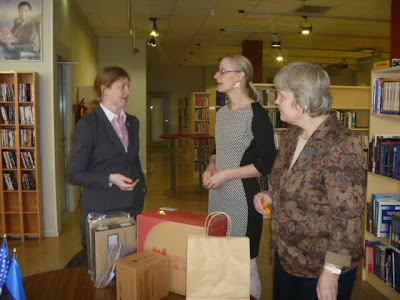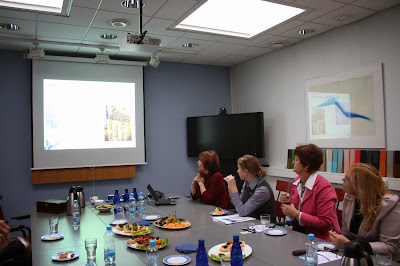Tallinn is really busy this time of year! So, yesterday I escaped
the hustle and bustle of the capital with our intern Ayesha Hamza and our Protocol
Assistant Laine Lembavere to head to one of Estonia's cultural treasures, the City
of Viljandi. Our first stop was to meet with Viljandi's newly elected mayor,
Ando Kiviberg. He is famous in Estonia for being the organizer of Estonia's
most popular annual folk music festival which is held in Viljandi every year. I
met him there this summer, along with Ambassador Levine, when the U.S. Embassy
brought an Alaskan Inuit music group, PAMYUA, to play on the main stage. He was
as energetic as I remember him being and was really excited about Viljandi's
future and its potential to become a worldwide destination for music and the
arts.
Our next stop was the Kondas Center which features an excellent
variety of paintings by Viljandi's own Paul
Kondas. We were accompanied by Krista Kull, the head of the Department
of Public Relations and Tourism at Viljandi's City Government. Krista, who is
always eager to show off Viljandi's cultural offerings, took us through several
new exhibits - one that features a modern and ironic take on puppetry and
another, art inspired by mushrooms!
From there we departed for Viljandi High School where I gave a
presentation on U.S. history viewed through pop culture and my enthusiastic
intern gave a quick talk on an English learning video game produced by the U.S.
State Department called “Trace Effects.” We also got a tour of the high school
which is the first of its kind on the county level in Estonia, in that it only
has 10th, 11th, and 12th grade (most Estonian schools are 1st through 12th
grade). The school actually includes two buildings - one a restored 1928-built
school house which was constructed by Estonian farmers for their children, and
the other a modern steel and glass structure which has tons of light, open
spaces, and creative approaches to learning environments. The school also puts
great trust in their students, and at the same time demands great
responsibility from them; there are no bells or chimes to indicate when class
is starting and students have a great deal of autonomy in their study choices.
All-in-all it was a fantastic visit; the students were really engaged and we
all had a lot of fun.
Our final stop for the day was Viljandi's American Corner, which is
situated in a bright corner in the city's library. There we delivered some new
video conferencing equipment that will soon be used to help the center conduct
live seminars with American experts, English language competitions and other
activities. Next year will be the 10th anniversary of this American Corner and
we're so pleased with all that we've accomplished together, from hosting
exhibitions to visiting music groups, film clubs, lectures, and other goings
on. They have been an excellent partner to the Embassy and one that we have
been happy to support. Finally it was time to hit the road and get back to
Tallinn. I find that every time I go to Viljandi, it is a unique and rewarding
experience. It is a place that always has something new to offer but preserves
the best of Estonian traditions. As a past U.S. Ambassador has said, it is
truly a cultural treasure.
Blog post by Assistant Public Affairs Officer Alison Davis
Photos taken by PAS Intern Ayesha Hamza and
Protocol Assistant Laine Lembavere
 |
| Ali delivered new video conferencing equipment to the Ameican Corner at Viljandi's city library. |
Blog post by Assistant Public Affairs Officer Alison Davis























































